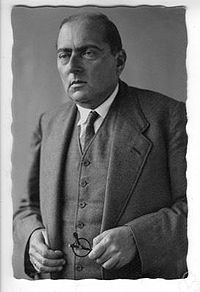Name Otto Toeplitz | Role Mathematician | |
 | ||
Born August 1, 1881Breslau ( 1881-08-01 ) Doctoral students Hans SchwerdtfegerHelmut Ulm Known for Hellinger–Toeplitz theoremSilverman–Toeplitz theoremToeplitz matrix Books The calculus, The Enjoyment of Math, Integralgleichungen Education University of Gottingen, University of Wroclaw Similar People Hans Rademacher, Otto E Neugebauer, Jakob Rosanes, Heinrich Scholz | ||
Toeplitz's Conjecture is Solved!
Otto Toeplitz (1 August 1881 – 15 February 1940) was a German Jewish mathematician working in functional analysis.
Contents
- Toeplitzs Conjecture is Solved
- Gordon Hamilton at the AIM Math Teachers Circle Part 2
- Life and work
- Quotes
- Books
- References
Gordon Hamilton at the AIM Math Teachers' Circle - Part 2
Life and work
Toeplitz's father and grandfather were mathematics teachers. Toeplitz studied mathematics in the University of Breslau and was awarded a doctorate in algebraic geometry in 1905. In 1906 Toeplitz arrived to Gottingen University, which was then the world's leading mathematical center, and he remained there for seven years. Mathematics faculty included David Hilbert, Felix Klein, and Hermann Minkowski. Toeplitz joined a group of young people working with Hilbert: Max Born, Richard Courant and Ernst Hellinger, with whom he collaborated for many years afterward. At that time Toeplitz began to rework the theory of linear functionals and quadratic forms on n-dimensional spaces for infinite dimensional spaces. He wrote five papers directly related to spectral theory of operators which Hilbert was developing. During this period he also published a paper on summation processes and discovered the basic ideas of what are now called the Toeplitz operators. In 1913 Toeplitz became an extraordinary professor at the University of Kiel. He was promoted to a professor in 1920.
In 1911, Toeplitz proposed the inscribed square problem:
Does every Jordan curve contain an inscribed square?This has been established for convex curves and smooth curves, but the question remains open in general (2007).
Together with Hans Rademacher, he wrote a classic of popular mathematics Von Zahlen und Figuren, which was first published in 1930 and later translated into English as Enjoyment of mathematics.
Toeplitz was deeply interested in history of mathematics. In 1929, he cofounded "Quellen und Studien zur Geschichte der Mathematik" with Otto Neugebauer and Julius Stenzel. Beginning in the 1920s, Toeplitz advocated a "genetic method" in teaching of mathematics, which he applied in writing the book Entwicklung der Infinitesimalrechnung ("The Calculus: A Genetic Approach"). The book introduces the subject by giving an idealized historical narrative to motivate the concepts, showing how they developed from classical problems of Greek mathematics. It was left unfinished, edited by Gottfried Kothe and posthumously published in German in 1946 (English translation: 1963).
In 1928 Toeplitz succeeded Eduard Study at Bonn University. In 1933, the Civil Service Law came into effect and professors of Jewish origin were removed from teaching. Initially, Toeplitz was able to retain his position due to an exception for those who had been appointed before 1914, but he was nonetheless dismissed in 1935. In 1939 he emigrated to Palestine, where he was scientific advisor to the rector of the Hebrew University of Jerusalem. He died in Jerusalem from tuberculosis a year later.
Quotes
Here is how Gottfried Kothe, who was Toeplitz's assistant in Bonn, described their collaboration:
In his own words:
